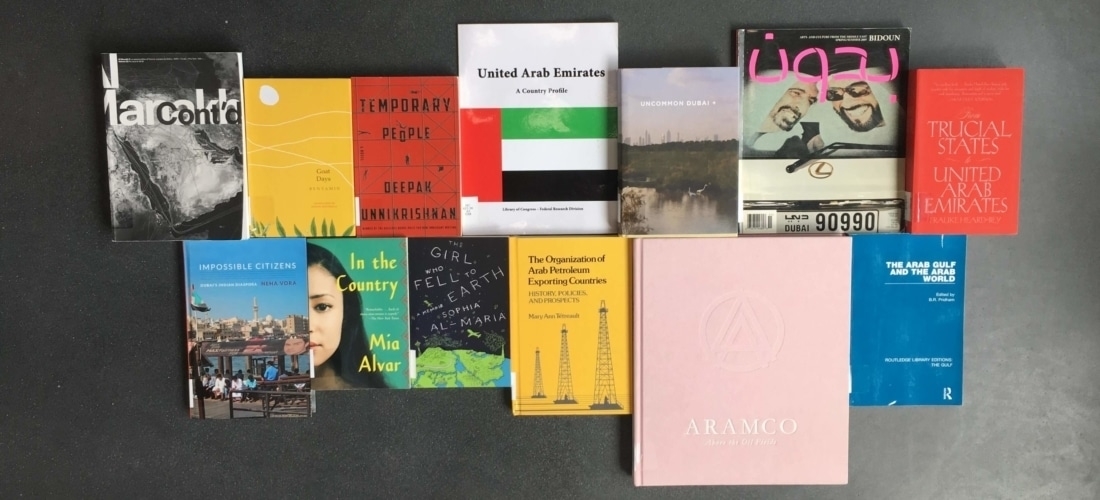Jameel Library presents an English language reading group under Reading the Gulf, involving five moderators, starting from April through to August 2019.
Reading the Gulf thinks about what it means to live and work in the Gulf, mainly through the lenses of urban theory, social structures and critique of Gulf studies literature. The sessions vary in approach and focus on participatory urban development, ‘direct urbanism,’ and political influences in popular culture including Manga.
To register, please email your full name and preferred session(s) to library@artjameel.org. Each session will be open to 15 participants, on a first-come first-serve basis. Participants are expected to commit to the reading material.
Readings are sent directly to the registered participants.
Rana Al Mutawa: April 27
This session looks into literature produced on urbanity and the use of public spaces in the Gulf. It compares two approaches in literature and research that is produced on the region. One that depicts new developments as segregated and ‘sanitised’ and older spaces ‘authentic’ and public; while the other presents rhetoric that explores the social meanings behind these newer commercial spaces.
Rana AlMutawa is an Emirati PhD candidate at the University of Oxford researching urban space in the Gulf. Her dissertation explores the every-day lives of middle-class Emiratis and long-term residents in Dubai, and their relationship to the city. Her other work includes research on nationalism and identity, gender, and education in the GCC.
Mohammad Shaibani: June 22
Addressing the popularity of Manga in the Gulf, this session thinks about the cultural and political implications behind the phenomenon, from the choices of Arab voice-over actors, to dubbing and music compositions. The discussion focuses on timelines, affiliations and critical readings of the genre.
Mohammad Alshaibani is an Emirati comic-book artist. He received his Bachelor of Science in Graphic Design from the American University of Sharjah and his Masters of Fine Arts in Sequential Art from the Savannah College of Art and Design. Mohammad has exhibited with Fn Design in their first Fakie D exhibition and the first Project MEGA Exhibition, and has contributed to Amor, A Magazine of Random with his recreation of Frank Miller’s The Dark Knight Returns. Mohammad resides in Dubai where his drawing time is divided between finishing pieces and chasing his nieces for his materials.
George Katodrytis: August 3
From the 2004 ‘Metropolitan Dubai and the Rise of Architectural Fantasy’ to the 2018 ‘Aficionados of the Unhomely Center and the Idio(ts)syncrasy of the Periphery’ and from the ‘mega’ to the ‘social’ every aspect of the city has seemingly been reported. Yet Dubai has not ceased to inspire on its future urbanism. In a domain of abundant real estate speculative developments where the imaginary is sold as the real, there is no longer a place for the real. Paradoxically the center of Dubai is doing the opposite: the real has become imaginary. There is no architectural past to romanticise, only the future to fantasize about, and a present to consume: direct urbanism.
George Katodrytis is a professor and Head of the Department of Architecture at the American University of Sharjah. Katodrytis is an architect involved in practice, teaching and research. He studied and taught at the AA in London. He published widely on contemporary architecture, urbanism, cultural theory and digital media. The work addresses the UAE ‘city’, especially as it is evolving in the 21st century. He is also the co-editor of the AD issue ‘UAE and the Gulf: Architecture and Urbanism Now.’
Adina Hempel: September 14
The urban landscape of cities along the Arabian Gulf has witnessed a significant growth over the past decades. While cities are a manifestation of cultural, economic and technological progress at a given time and place, they are also a response to community needs in the best-case scenario. How does urban participatory development in the Gulf differ from methods used in other parts of the world and what are ensuring factors for its success?
Adina Hempel is a registered architect, urban researcher and Associate Professor at the College of Arts and Creative Enterprises at Zayed University in Dubai, UAE. She was appointed Head of Research for the curatorial team of the National Pavilion of the UAE at the 14th International Architecture Exhibition in La Biennale di Venezia, and served as Head of Research for the Shindagha Historic District. Adina received a Dipl.-Ing. of Architecture (Master in Architecture) from the Technical University of Dresden/Germany, studied Urban Studies at Columbia University in New York and Digital Film Making at New York Film Academy in New York.
August also features a session by Deepak Unikrishnan which will be announced shortly.
SEE ALL EVENTS